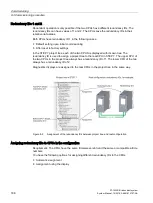
Commissioning
9.4 Operating and system states
S7-1500R/H redundant system
System Manual, 10/2018, A5E41814787-AA
197
9.4
Operating and system states
9.4.1
Overview
Operating states
Operating states describe the behavior of an individual CPU at a specific time. Knowledge of
the operating states of the CPUs is useful for programming startup, testing and error
diagnostics. The status LEDs on the front of the CPU and the CPU display indicate the
current operating state.
Like standard S7-1500 CPUs, the S7-1500R/H CPUs have the operating states STOP,
STARTUP and RUN. For operation as redundant system, one of the two CPUs can take on
an additional operating state, SYNCUP, for synchronizing the two subsystems. The
operating state RUN is divided into RUN, RUN-Syncup and RUN-Redundant for redundant
systems.
System states
The system states enable the direct assessment of the behavior of a redundant system.
They result from the combination of the operating states of the individual CPUs.
Event-controlled synchronization
Event-controlled synchronization ensures that both CPUs in a redundant system can operate
redundantly (RUN-Redundant system state).
For all events that could result in different internal subsystem states, the operating system
automatically synchronizes the data of the primary and backup CPU.
Primary and backup CPU are, for example, synchronized in the event of:
●
Direct access to the IO devices
●
Events that interrupt cycle program execution
●
Updates to user times, for example S7 timer
●
Updates to the process image
●
Changes to data through communication functions
●
Access to data that could be different on the different CPUs, for example current time,
system time, or runtime messages
Содержание Simatic S7-1500H
Страница 1: ......
















































